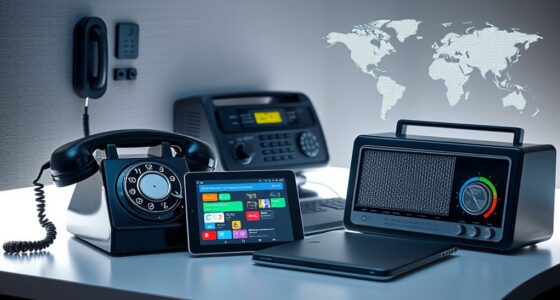Early intervention for congenital deafblindness works best when you start early and focus on sensory integration, communication, and daily routines. Creating a predictable environment with tactile cues, using supportive technology, and applying tailored strategies help your child process sensory information and develop language skills. Collaborating with specialists and being consistent in your approach boosts your child’s independence and confidence. Keep exploring these strategies to unlock more effective ways to support your child’s growth.
Key Takeaways
- Initiate early, individualized interventions focusing on sensory integration and communication to optimize developmental outcomes.
- Use consistent tactile cues and sensory-rich activities tailored to the child’s unique sensory profile.
- Incorporate technology and adaptive devices to enhance sensory processing and facilitate communication.
- Embed strategies into daily routines and collaborate with specialists to ensure tailored, flexible support.
- Prioritize building meaningful environmental connections and promoting independence through supportive interactions.

Early intervention plays an essential role in supporting children with congenital deafblindness, as it can substantially improve their developmental outcomes. When you start early, you give your child the best chance to develop fundamental skills and build meaningful connections with their environment. A key part of this process involves understanding sensory integration, which refers to how your child processes and responds to different sensory information. Children with congenital deafblindness often experience challenges in sensory integration because they may have limited access to visual and auditory stimuli. As a caregiver or practitioner, you can implement strategies that help your child better interpret and respond to sensory input. For example, creating a consistent and predictable environment helps your child feel secure and reduces sensory overload. Tactile cues, such as gentle touch or textured objects, become essential tools for helping your child explore their surroundings. Incorporating sensory-rich activities tailored to your child’s specific needs promotes their ability to integrate sensory information more effectively. Additionally, understanding the role of technology and automation in supporting early intervention can provide innovative tools to enhance your child’s development.
Alongside sensory integration, developing effective communication strategies is fundamental for early intervention. Since children with congenital deafblindness often face difficulties in accessing typical language cues, you need to find alternative ways to foster communication. Using tactile signing, hand-over-hand guidance, or braille can open channels for your child to express their needs and feelings. Consistency and patience are essential when applying these methods, as your child may require time to understand and use new forms of communication. It’s also important to observe how your child responds to different cues and adapt your strategies accordingly. The goal is to build a foundation that encourages your child to interact and share their experiences, which in turn supports their overall development.
Incorporating sensory integration and communication strategies into your child’s daily routine can make a significant difference. Early intervention isn’t just about addressing deficits; it’s about creating an environment that nurtures your child’s strengths and promotes independence. By working closely with specialists, you can learn specific techniques tailored to your child’s unique sensory profile and communication style. Recognizing that every child is different, you should remain flexible and responsive to their evolving needs. Through consistent, supportive, and tailored interventions, you’re helping your child navigate their world with greater confidence and joy. Early action today sets the stage for greater opportunities and improved quality of life tomorrow.
Frequently Asked Questions
How Can Families Best Support Early Intervention at Home?
You can best support early intervention at home by establishing consistent routines that promote communication and learning. Your active involvement is key—spend quality time engaging in activities that stimulate senses and encourage interaction. Incorporate these practices into daily life, making them natural parts of home routines. Your dedication helps your child develop essential skills, and your presence makes a significant difference in their progress and confidence.
What Role Do Technology and Assistive Devices Play?
Technology and assistive devices play a vital role in supporting sensory integration for individuals with congenital deafblindness. You can use adaptive technology like tactile communication tools or specialized hearing devices to enhance their environment. These tools help improve interaction and learning by bridging sensory gaps. By integrating such technology into daily routines, you empower your loved ones to develop essential skills and foster independence effectively.
How Do Cultural Differences Influence Intervention Strategies?
You’ll find that cultural differences considerably influence intervention strategies. Cultural barriers and parental beliefs shape how families perceive and engage with support services. Respecting these beliefs helps you build trust and tailor approaches that resonate locally. By understanding and integrating cultural context, you can create more effective, inclusive interventions that empower families, ensuring they feel valued and understood throughout the support process.
What Are Signs That Early Intervention Is Not Effective?
You should watch for signs that early intervention isn’t working, like misinterpreted behaviors or delayed responses. If the child doesn’t show improvement over time, or if communication attempts remain ineffective, these could indicate the strategies aren’t meeting their needs. It’s essential to reassess your approach and consult specialists, ensuring you adapt interventions to better support their development and prevent frustration for both you and the child.
How Do Professionals Coordinate Multidisciplinary Care?
You can enhance care by guaranteeing an integrated team works together seamlessly. Professionals coordinate care through regular communication, shared goals, and clear roles, which improves outcomes. Use care coordination strategies like case meetings, shared documentation, and collaborative planning to address each child’s unique needs. This team approach fosters consistency, builds trust with families, and ensures that interventions are cohesive, effective, and tailored, ultimately supporting better development for the child.
Conclusion
Remember, early intervention is your best tool when supporting someone with congenital deafblindness. By starting sooner rather than later, you can make a real difference in their development and quality of life. The right strategies and teamwork can release their potential—showing that where there’s a will, there’s a way. Don’t wait for the perfect moment; take action today, because as the saying goes, “A journey of a thousand miles begins with a single step.”











